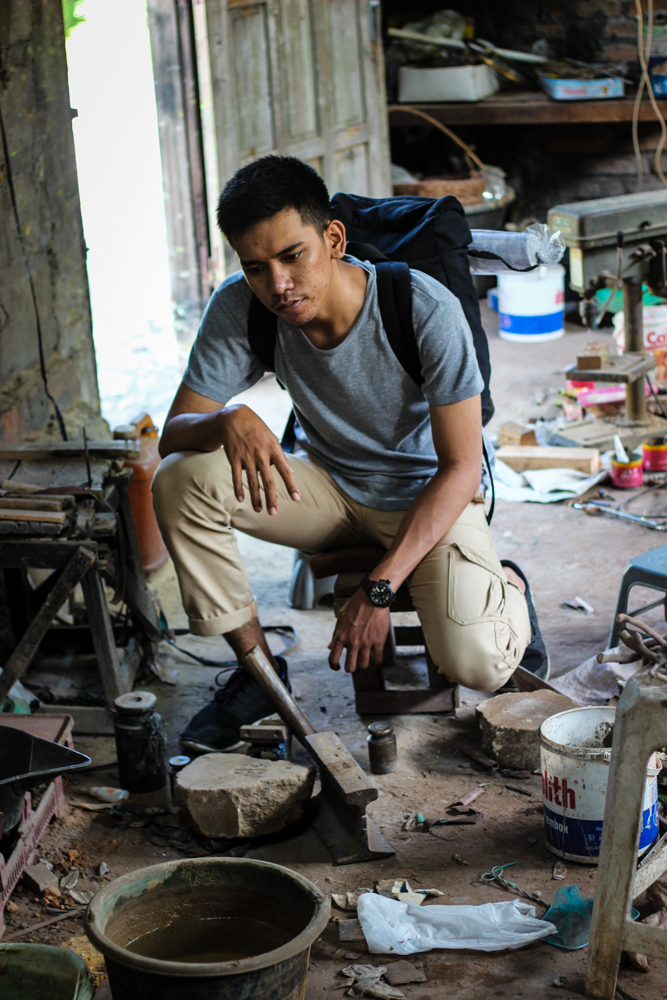Indonesian Craft :: Riding with Rafheoo Part 2
In the second of three articles, Frank Sedlar continues to explore the Indonesian artistic tradition featured in the bags of Jakarta-based Rafheoo from the ancient Javanese city of Yogyakarta.
Our day begins with the traditional Indonesian breakfast of coffee and cigarettes. Between puffs and pours we talk Yogyakarta, the historical center of Javanese culture and long renowned for its artists. We’re here for two in particular – Pak Wanto for his brass buckles and Cetul for his tooled leather. Components that will shine on Rafheoo’s packs.
As the mellowness of the Indonesian tobacco begins to mix with the potency of the Javanese caffeine we embark on a pair of motorbikes to the hills surrounding Yogyakarta. When the incline of the dirt road begins to worryingly slow the progress of our bikes Pak Wanto’s workshop materializes around a bend. Pak Wanto’s wiry frame and weathered smile beckons us into his workshop, a small cinderblock room with a worn dirt floor. A pile of spent bullet casings gleam in one corner, heaps of dusty brass shapes in the other. Elegant sculpted molds line the walls, a testament to Pak Wanto’s skill with hot brass and fire. A barrel of gas is propped up in the far corner, threatened to be engulfed by the rudimentary kiln it’s meant to fuel.

Inheriting metalworking from his father, Pak Wanto can count on one hand the number of workshops in Yogyakarta still casting brass in the old method. This method, like everything else on this trip, is immensely involved and performed entirely by hand.

Starting with a stack of old wooden frames and a pile of special dirt from the far away city of Semerang, Pak Wanto methodically begins casting the molds by positioning a stencil beneath successive layers of Javanese soil. Inserting a pin as if to allow the metal to breath, he then commences an intricate pattern of footwork on the frames, motions that more closely resemble a dance.


Moving deftly to the earthen kiln, Pak Wanto ignites a flame that is instantly seething thanks to the addition of a healthy dose of gasoline. Since the fire will take some time to reach the correct torrid temperature and the already warm atmosphere inside the workshop is rapidly becoming unbearable, it’s decided to let the fire mature while we wander up the dirt road to find some lunch.

Thirty minutes later I’m relieved to find Pak Wanto’s workshop not consumed by flames. The casting process begins with a handful of brass bullet casings thrown into the flames. Instantly they morph into a shimmering soup. Indonesian Alchemy. Undeterred by the molten brass, Pak Wanto attentively peers deep into the fire before extracting a brazier of brass, calmly depositing a splash into each of the molds.



Minutes later the smoldering brass is dislodged from its wooden frame amidst a pile of smoking dirt. Pak Wanto quickly extracts from this revered earth his creations, inspecting them once before moving onto the next batch. A brisk inspection but there’s little reason to doubt the prowess of this Javanese alchemist.


Two of these buckles will array a Rafheoo bag, buckles that thanks to the skill of Pak Wanto can be perfectly tailored to Rafheoo’s designs. A further testament to the Indonesian handicraft tradition imbued in Rafheoo’s bags. With a bag full of crisp Pak Wanto metal we bid farewell to the master, a man resolute on forging his antique method into the modern Indonesia landscape.

Weaving through the vibrant streets of Yogyakarta we reach a small cluster of houses framed by the looming Mount Merapi on the horizon. The final workshop on our itinerary belongs to Cetul. A renowned rock climber in earlier days with intensely tattooed arms, his delicately framed glasses now present him in a more contemplative air.

Living and working amongst a group of equally talented leatherworkers, all self-taught, Cetul’s workshop is collectively putting forth some incredibly original designs in tanned cowhide. Their ethos, similar to the other workshops Rafheoo works with, is make for the simple sake of making. It’s a group of leatherworkers digging deep into their creativity, unmotivated by the stifling sway of a dollar sign.

Case in point, the four leather lashings that Cetul is tooling for the Rafheoo bag each take upwards of an hour to create. Economics be damned, it’s a partnership that rests upon a simple desire to work amongst friends and collectively put forth an array of beautiful and authentic material.

Cetul’s process is determinedly simple. A hard surface – in this case a tombstone (RIP Supranto) – a hammer, a pin and a 6mm thick piece of tanned leather. Cetul then begins conducting a symphony of hammer strikes – tick tick tick tap, tick tap tick, tick tick tick tap. Through the thousands of individual notes a topography of edelweiss flowers begins to materialize on the face of the leather, delightfully similar to the flora patterning of the batik textile.


Despite the complexity of the design, Cetul maintains an engaged conversation. His hands tap away while his mouth rattles off jokes with his growing audience. Once the tooling is complete a few light brushstrokes of leather conditioner and sharp trims with a knife finish off the lashing. I almost plead with Cetul not to cut out the typical two grooves into this exquisite piece of cowhide.


Bidding farewell to Cetul, his collective, and the street hawkers who regularly stop by to examine the day’s leather workings, we board a train bound for Jakarta. With a carefully curated and even more precisely constructed array of Javanese handicraft in tow, we’re making a beeline for Rafheoo’s workshop to piece together a few bags. Bags with which Rafheoo aims to introduce the skill of an emerging generation of Indonesian artistry, a generation steeped in tradition but decidedly reimagining their storied Indonesian craft.

*Follow Frank’s adventures on Instagram!





 Carry Awards
Carry Awards Insights
Insights Liking
Liking Projects
Projects Interviews
Interviews















